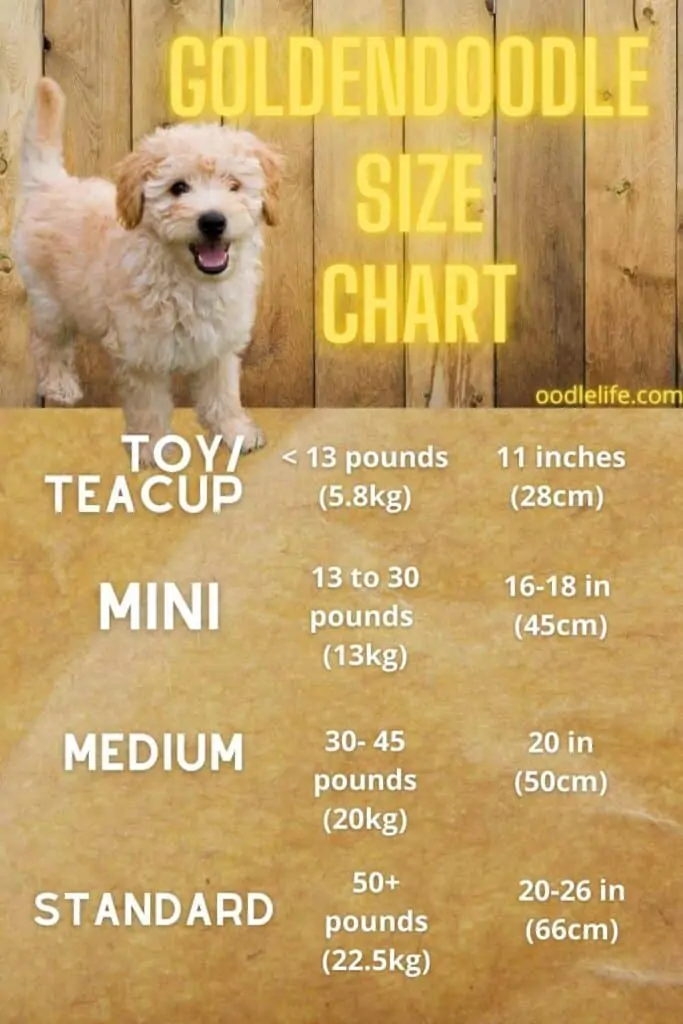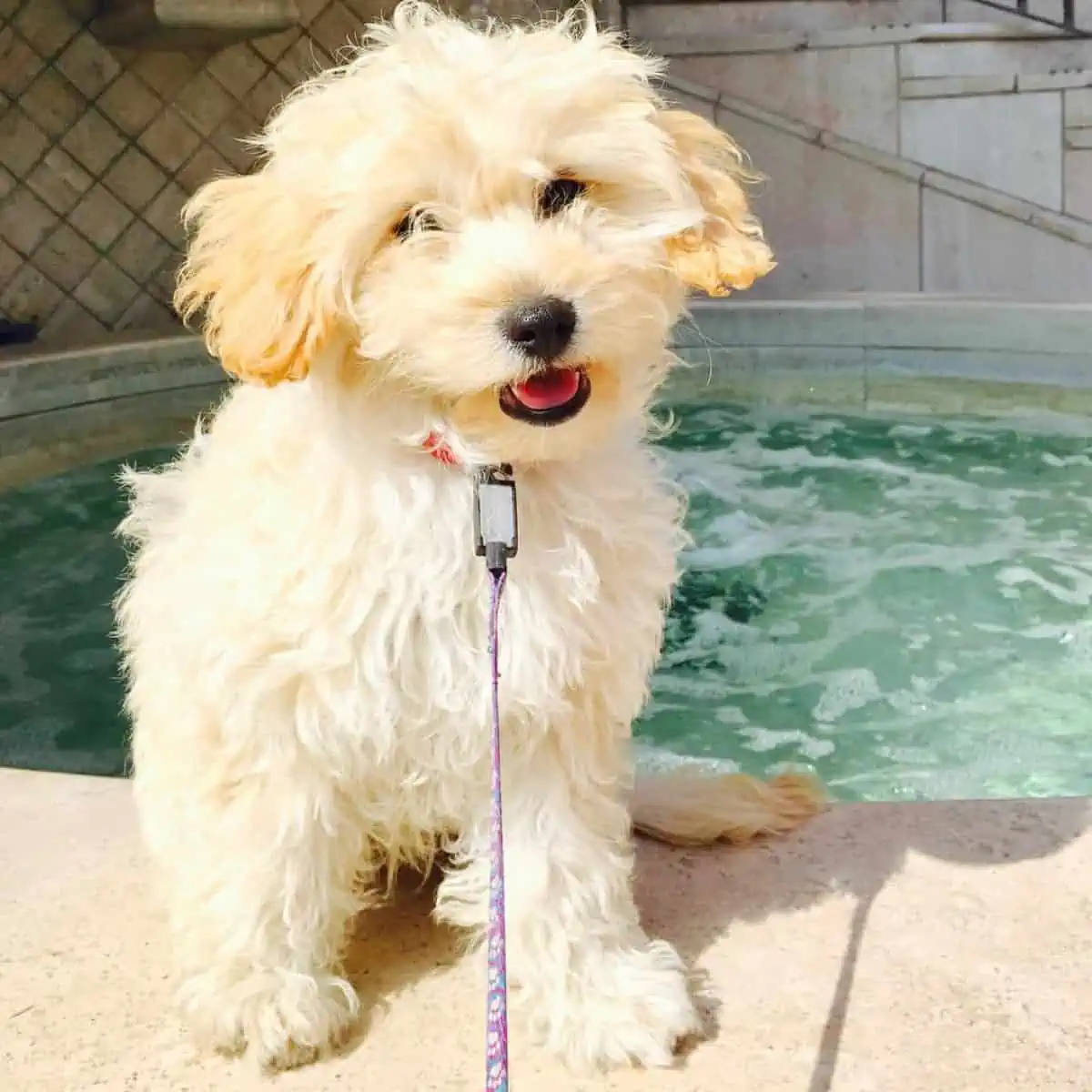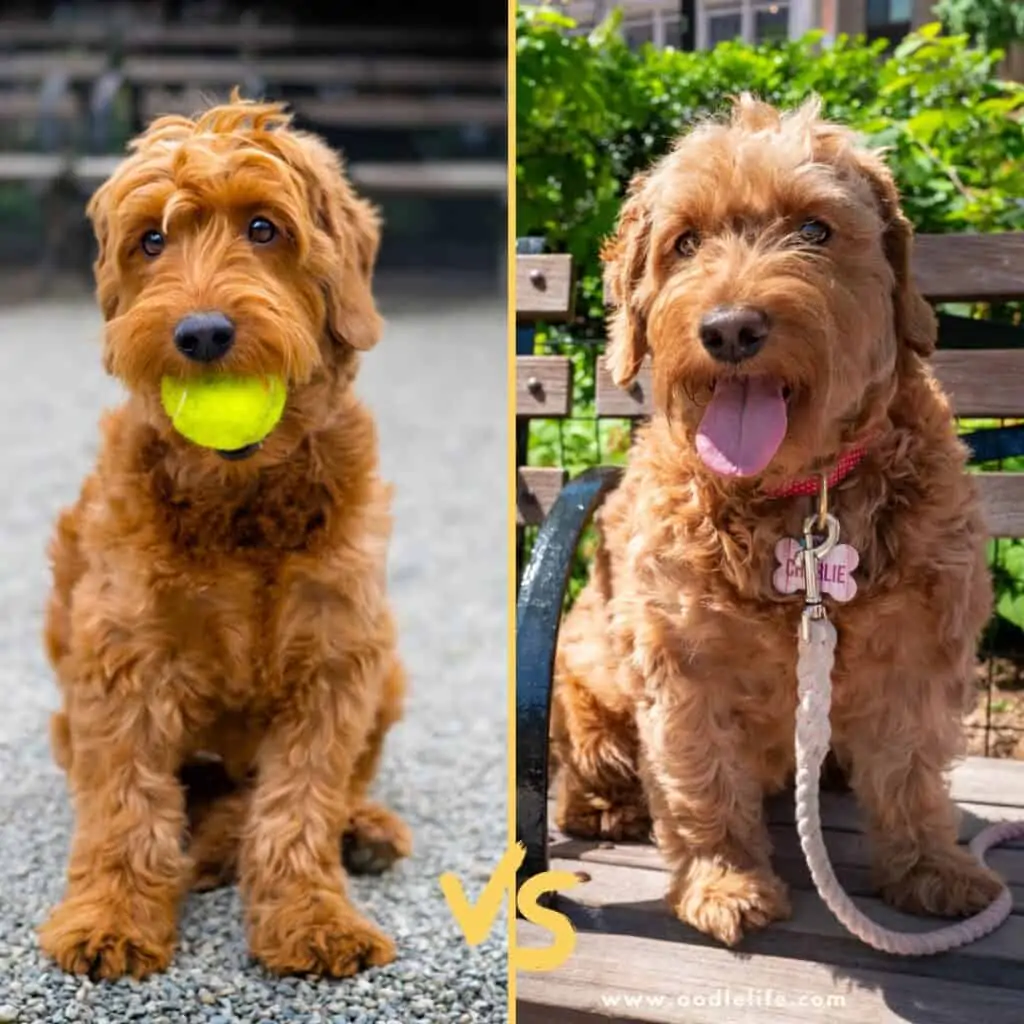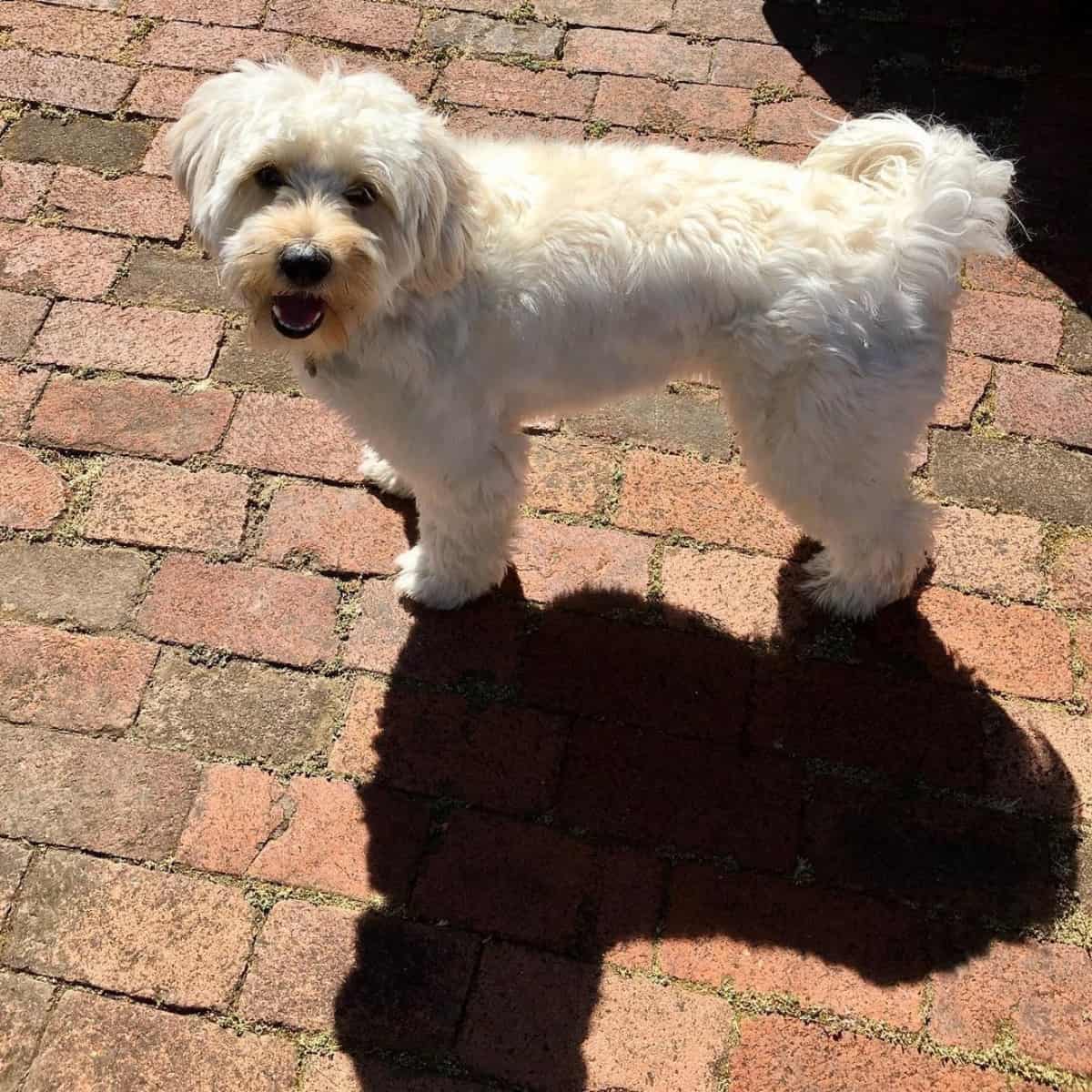How Big Do Goldendoodles Get? [Goldendoodle Size Chart]

So, you have finally decided to go out and get a Goldendoodle, but you’re probably wondering; how big do these dogs get? You know that they’re cute, you know that they’re fuzzy, and you know that they’re super friendly, but what about the size?
How big do Goldendoodles get?
Well, there are actually a variety of different sizes when it comes to Goldendoodles, but the 3 most common sizes are the mini Goldendoodle, the medium Goldendoodle, and the standard Goldendoodle.
Though there is no way to 100% predict which size it will be when fully-grown (as with all hybrids), we can certainly take a look at commonalities across the spectrum, and narrow down some of the characteristics of the 3 main sizes.
Goldendoodle Size Chart
Here is the complete Goldendoodle size chart covering the four most common sizes. There is no official sizing chart but most of the Goldendoodle association and groups follow these numbers.

How big will a Mini Goldendoodle puppy Get (Teacup, Toy and Mini)
The next size of Goldendoodle we are going to discuss is the smallest of the bunch, the mini Goldendoodle. When looking at mini Goldendoodles, they can actually be further broken up into 3 distinct classes: Teacup, Toy, and (official) Mini.
Teacup Goldendoodle Size

(See the complete Teacup and Toy Goldendoodle Size Guide)
These cute little guys are the smallest size of the Goldendoodle breed. Though with less size, comes less responsibility (in terms of exercise). Teacup Goldendoodles are so tiny, that they would be perfect in just about any home, assuming of course they are treated with care.
They will grow to weigh less than 13 pounds, and stand around 11 inches tall once fully grown. As I’m sure you can imagine, this dog is extremely small, so much so in fact that they can easily be held in just one arm.
However, due to the way this style of Goldendoodle is bred, there is a lot of controversy over potential health risks. They are bred by taking the runt of each litter, and breeding them with small toy-sized Poodles, and so because of this there is a greater chance of them suffering from genetic defects.
Aside from the health complications, Teacup sized Goldendoodles are also extremely expensive, and generally not sought after for this reason.
Many people cannot justify the price for the potential health risks that come along with owning a Teacup sized Goldendoodle.
Toy Goldendoodle Size

This type of Goldendoodle is the second smallest size (behind the Teacup), typically weighing in at around 20 pounds or so, and 14-15 inches in height when fully grown.
This is the perfect dog for someone who maybe is more confined to a smaller living space (apartment, condo, RV), and still wants a small, loveable teddy bear to help keep them company.
Also, with this style of Goldendoodle, they are likely to have less energy, which Is ideal for somebody who doesn’t have the time, or drive to deal with a bigger, more rambunctious pup.
Mini Goldendoodle Size

The term “Mini” is used to describe any Goldendoodle under 30 pounds, and so both the “Toy”, and Teacup” sized doodles would technically fall under the classification of “Mini”.
With that being said, when you talk to most breeders they will typically separate the 3, and classify “Mini” Goldendoodles as dogs that weigh between 20-30 pounds, and 16-18 inches tall when fully grown.
It is easily the most popular size of the 3 main sizes (Mini, Medium & Standard), and often sought because they can only get so big.
The bigger dogs on average are far more active than the smaller breeds, and Goldendoodles are one of the most active breeds out there.
Therefore, many pet owners opt to go for a Mini Goldendoodle because they will have less energy, and so won’t need to be walked, or exercised nearly as often. But do NOT expect a lethargic dog. Frequent exercise is a must for a Miniature Goldendoodle.
How big do Medium Goldendoodles Get?
Another tremendously popular option is the medium size, as these Goldendoodles are small enough for people who live in apartments/condos, but still big enough to serve as working dogs, or a good family pet.

This class typically stands at 15-20 inches from the shoulder to the floor, and about 30-45 pounds in weight when fully grown (which typically takes about 11-13 months).
Medium Goldendoodles are often sought after because they are the perfect in-between, being that they are not too big, but not too small either, very similar to their parent breed the Golden Retriever.
They preserve the friendliness and outgoing nature of the Golden Retriever, and the intelligence/allergy-friendliness of the Poodle.

While size can vary greatly across the different types of Goldendoodles, the most important thing to remember is that reputable breeders do the best job of maintaining the temperament of both dogs, no matter the size.
Medium Goldendoodles are great for most pet owners, although because they are very playful and energetic, they will still need a good amount of space to let loose.
A medium size Goldendoodle is ideal for somebody who wants a fun and energetic dog, that’s not TOO big, and still has all of the reputable qualities of both the Golden Retriever parent, and the Poodle.
How big do Standard Goldendoodles get?
This style of Goldendoodle is the largest of the 3, weighing in at 50-90 pounds, and a height of 20-26 inches from the floor to their shoulders when fully grown. They are a larger breed that typically becomes fully-grown at 12-16 months.

Due to the size of this class of doodle, they are going to require far more space, and more attention/detail to exercise. As previously mentioned, the bigger the pup, the more energy they will need to exert, and so for this breed (being that it’s the largest), it will need ample room to play, as well as attention.
With that being said, they will also have a far sturdier build than most breeds, and are looked at as your “typical” Goldendoodle. Another advantage to these Goldendoodles is that because they are so big, they actually turn out to be great watch dogs (even though they aren’t overly aggressive).

Surprisingly enough, Goldendoodles carry a lot of qualities which make them great family pets, one of which is their level of alertness. They make for incredible watch dogs because they are bigger than the other Goldendoodles, but are still extremely protective of their loved ones, and can certainly be loud if they need to be.
The standard Goldendoodle is ideal for somebody who has a lot of space around the house, and a park nearby to play in. They are easily the most active, and energetic of the bunch, and the fact that they love the water (and the outdoors in general), means you could be in for a busy summer.
How to decide what size of Goldendoodle to get?
Now that we have explained the different sizes of Goldendoodles, we will now help narrow it down to which size is best for you. We have reviewed some of the most important factors to consider before purchasing a Goldendoodle, and explained them below.
Size consideration 1: The Space You Have/Exercise Needs
The first aspect that you are going to want to consider is how much open space you have for the dog to play. This doesn’t necessarily have to be inside the house, but whether it be your backyard, or a park nearby, it is paramount that you understand the exercise needs for each specific size.
As stated previously, the bigger the dog the more exercise they will need, and so if you are considering getting a medium or a standard Goldendoodle, make sure that you have an ample enough living space to support them. Take the time each and every day to take them for walks, play with them, and keep them socially active.
Size Consideration 2: Are There Kids In The House?

Another important factor to consider is whether or not there are kids in the house. If there are, then you have to seriously contemplate going for a larger Goldendoodle, because if the child does get rowdy, than they won’t be able to harm the dog.
Now it is important to note that even though this breed is known to be good with kids, any dog can snap if provoked. The key is to approach it with love, and caution, and try to always keep an eye on the child with the pup.
The good news is that all Goldendoodles are extremely friendly, and amazing around children, however with the smaller size dogs you always have to be careful when they’re around kids.
These little pups can be so delicate, and fragile (and even sometimes skittish), that you have to be very careful when you’re around them.
Sometimes when kids get playing, and aren’t paying attention to their surroundings, they can fall, knock things over, and can seriously injure themselves or the dog.
Size Consideration 3: Health Complications
Another serious thing to consider are the potential health complications that come with mixed breeds. Though Goldendoodles are a quite healthy breed overall, the two parent breeds are prone to certain diseases such as specific cancers, and genetic illnesses.
For example, due to how they are bred, mini Goldendoodles are more susceptible to things like: progressive retinal atrophy, Von Willebrand’s disease, bloat (gastric dilatation volvulus), Patellar Luxation, and Hypothyroidism.
A mini Goldendoodle should be bred from the smallest healthy Goldendoodels and small Poodle – not any dog that is small due to health reasons. A reputable breeder will ensure this.
A cruddy puppy mill may breed a Miniature Goldendoodle by taking the runt of the litter, this can provide some very serious health problems from infection predisposition and allergies, to hip dysplasia and more.

CONCLUSION
In summary, understanding the different sizes and what is required from YOU as a pet owner is essential. No matter what the mixed breed is, dogs of all sizes have specific needs, and situations that are best for their growth, and happiness.
Take into account your surroundings, the people who live in the home, and how much time and effort you are going to be able to allocate towards the dog.
So many people venture on this journey of bringing in a sweet, loving doggo into their home, only to then realize they don’t the time, space, or energy to keep them. This is why you should look beyond the breeder and look for a Goldendoodle rescue if you are after a larger dog.
The purpose of this article is to make sure you are not one of those people, and are the most well informed on what each size requires from the owner.
With that being said, Goldendoodles are one of the sweetest, most loving, and family-friendly pups out there, and if given the proper amount of care and admiration, can make for tremendous companions.